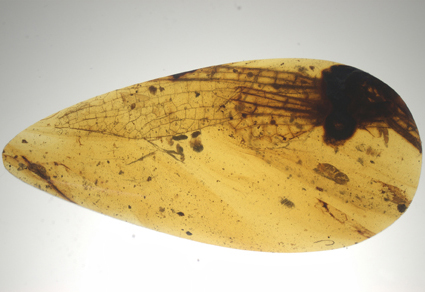Abstract
The fifth burmaeshnid dragonfly, Neoaeschna kachinensis gen. et sp. nov., is described based on the basal parts of a pair of fore- and hindwings from Kachin amber, indicating that Burmaeshnidae Huang, Cai, Nel & Bechly, 2017 is the most diverse family of true dragonflies in Kachin amber. The new dragonfly differs from the other genera in having one row of cells present in the postdiscoidal area basal of the midfork, the trigonal planate being obsolete, and one or two crossveins present basal of the CuP-crossing in the submedian space.
References
- Bechly, G. (1996) Morphologische Untersuchungen am Flügelgeäder der rezenten Libellen und deren Stammgruppenvertretern (Insecta; Pterygota; Odonata), unter besonderer Berücksichtigung der Phylogenetischen Systematik und des Grundbauplans der Odonata. Petalura, 2, 1–402.
- Bechly, G. (2007) Phylogenetic Systematics of Odonata. Available from: https://bechly.lima-city.de/system.htm (accessed 27 November 2007)
- Cockerell, T.D.A. (1913) Two fossil insects from Florissant with a discussion of the venation of the aeschnine dragon-flies. Proceedings of the United States National Museum, 45, 577–583. https://doi.org/10.5479/si.00963801.45-2000.577
- Cruickshank, R.D. & Ko, K. (2003) Geology of an amber locality in the Hukaung Valley, northern Myanmar. Journal of Asian Earth Sciences, 21, 441–455. https://doi.org/10.1016/S1367-9120(02)00044-5
- Fabricius, J.C. (1793) Entomologia systematica emendata et aucta: secundum classes, ordines, genera, species, adjectis synonymis, locis, observationibus, descriptionibus. Vol. 3. C G Proft, Hafniae [Copenhagen], 488 pp. https://doi.org/10.5962/bhl.title.125869
- Huang, D., Cai, C. & Nel, A. (2017a) A new Burmese amber hawker dragonfly helps to redefine the position of the aeshnopteran family Burmaeshnidae (Odonata: Anisoptera: Aeshnoidea). Cretaceous Research, 79, 153–158. https://doi.org/10.1016/j.cretres.2017.07.020
- Huang, D., Cai, C., Nel, A. & Bechly, G. (2017b) A new dragonfly family from the mid Cretaceous Burmese amber (Odonata: Aeshnoptera: Burmaeshnidae). Cretaceous Research, 78, 8–12. https://doi.org/10.1016/j.cretres.2017.05.025
- Leach, W.E. (1815) Entomology. In: Brewster, D. (Ed.), The Edinburgh Encyclopaedia. Vol. 9. Blackwood, Edinburgh, pp. 57–172.
- Matsumoto, T. (1954) Family Puzosiidae from Hokkaido and Saghalien (Studies on the Cretaceous Ammonoidea from Hokkaido and Saghalien-V). In: Series D, Geology. Vol. 5. Memoirs of the Faculty of Science. Kyushu University, Fukuoka, pp. 69–118.
- Nel, A., Martínez-Delclòs, X., Paichler, J.C. & Henrotay, M. (1993) Les ‘Anisozygoptera’ fossiles. Phylogénie et classification (Odonata). Martinia, Numéro Hors Série, 3, 1–311.
- Riek, E.F. (1976) A new collection of insects from the Upper Triassic of South Africa. Annals of the Natal Museum, 22 (3), 791–820. https://doi.org/10.10520/AJA03040798_608
- Riek, E.F. & Kukalová-Peck, J. (1984) A new interpretation of dragonfly wing venation based upon early Upper Carboniferous fossils from Argentina (Insects: Odonatoidea) and basic character states in pterygote wings. Canadian Journal of Zoology, 62, 1150–1166. https://doi.org/10.1139/z84-166
- Selys-Longchamps, E. de (1854) Monographie des Calopterygines. Mémoires de la Société royale des Sciences de Liège, 9, i–xi + 1–291. https://doi.org/10.5962/bhl.title.60461
- Shi, G., Grimaldi, D.A., Harlow, G.E., Wang, J., Wang, J., Yang, M., Lei, W., Li, Q. & Li, X. (2012) Age constraint on Burmese amber based on U–Pb dating of zircons. Cretaceous Research, 37, 155–163. https://doi.org/10.1016/j.cretres.2012.03.014
- Wei, G., Shih, C., Ren, D. & Wang, Y. (2019) A new burmaeshnid dragonfly from the mid-Cretaceous Burmese amber: Elucidating wing base structure of true Odonata. Cretaceous Research, 101, 23–29. https://doi.org/10.1016/j.cretres.2019.04.005
- Yu, T., Kelly, R.S., Mu, L., Ross, A., Kennedy, J., Broly, P., Xia, F., Zhang, H., Wang, B. & Dilcher, D.L. (2019) An ammonite trapped in Burmese amber. Proceedings of the National Academy of Sciences of the United States of America, 116, 11345–11350.
- https://doi.org/10.1073/pnas.1821292116
- Zheng, D., Chang, S., Jarzembowski, E.A. & Wang, B. (2017) The first aeshnoid dragonfly (Odonata: Anisoptera: Telephlebiidae) from mid-Cretaceous Burmese amber. Cretaceous Research, 72, 105–109. https://doi.org/10.1016/j.cretres.2016.12.013


